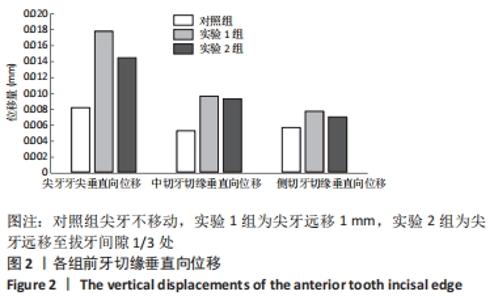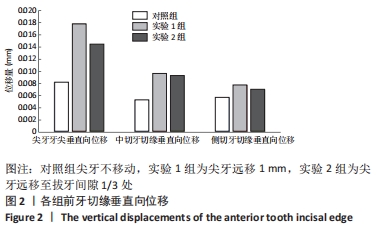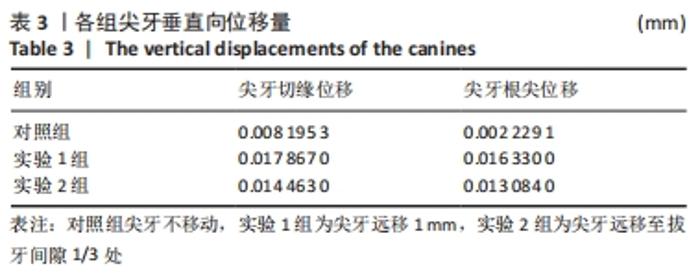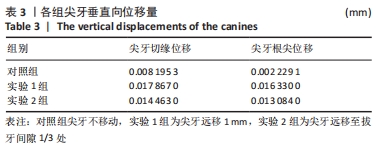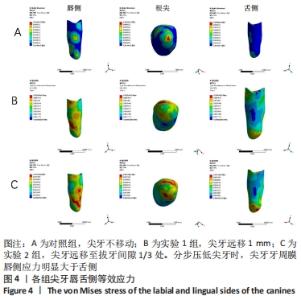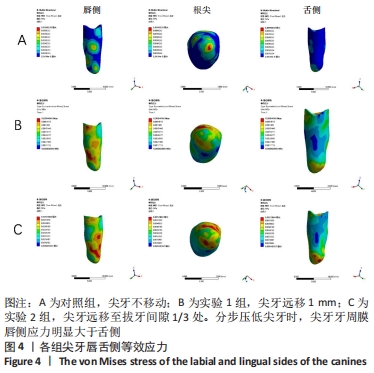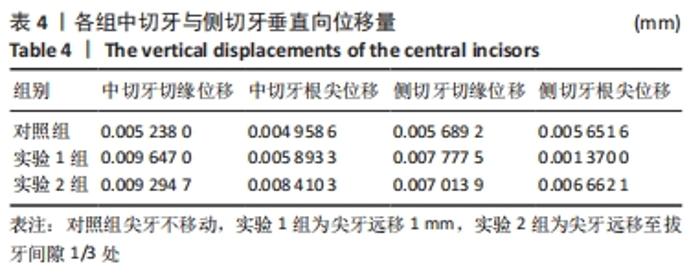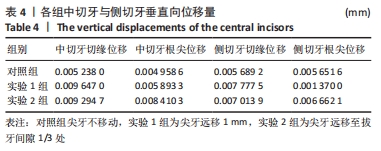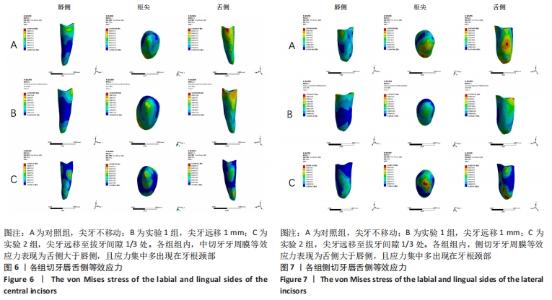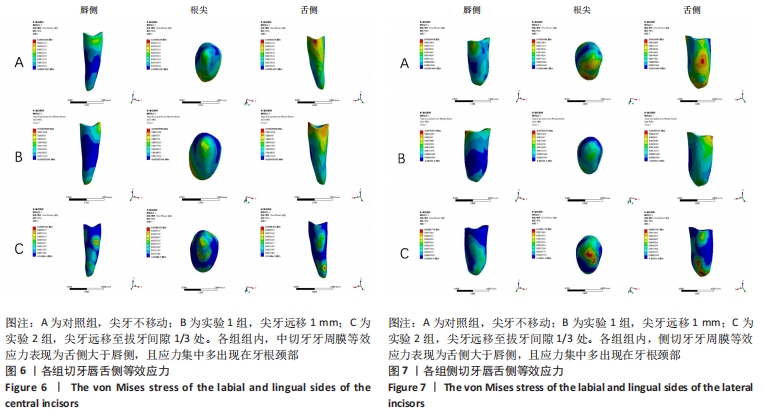Chinese Journal of Tissue Engineering Research ›› 2022, Vol. 26 ›› Issue (35): 5669-5675.doi: 10.12307/2022.1011
Previous Articles Next Articles
Finite element study on the effect of canine distal movement on anterior tooth intrusion by clear aligners
Chen Lin, Xu Xiaomei, Zhang Li, Xu Pengfei, Zheng Qian
- Department of Orthodontics, Affiliated Stomatological Hospital of Southwest Medical University, Luzhou 646000, Sichuan Province, China
-
Received:2022-01-24Accepted:2022-03-03Online:2022-12-18Published:2022-05-17 -
Contact:Zheng Qian, Master, Physician, Department of Orthodontics, Affiliated Stomatological Hospital of Southwest Medical University, Luzhou 646000, Sichuan Province, China -
About author:Chen Lin, Master candidate, Attending physician, Department of Orthodontics, Affiliated Stomatological Hospital of Southwest Medical University, Luzhou 646000, Sichuan Province, China -
Supported by:Sichuan Provincial Department of Science and Technology Project, No. 2021YJ0151 (to XXM); Southwest Medical University School-level Scientific Research Project, No. 2021LZMS019 (to XXM); Southwest Medical University, School of Stomatology-level Research Project, No. KQJG202104 (to ZQ)
CLC Number:
Cite this article
Chen Lin, Xu Xiaomei, Zhang Li, Xu Pengfei, Zheng Qian. Finite element study on the effect of canine distal movement on anterior tooth intrusion by clear aligners[J]. Chinese Journal of Tissue Engineering Research, 2022, 26(35): 5669-5675.
share this article
Add to citation manager EndNote|Reference Manager|ProCite|BibTeX|RefWorks
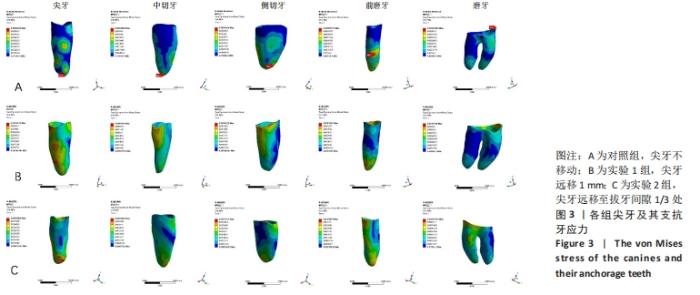
对照组尖牙最大等效应力为0.009 023 2 MPa,支抗牙中切牙最大等效应力为0.003 283 8 MPa,侧切牙最大等效应力为0.003 419 6 MPa,均大于前磨牙的最大等效应力0.000 857 5 MPa;磨牙的最大等效应力为0.000 478 2 MPa,为最小值。实验1组尖牙最大等效应力为0.009 404 9 MPa,中切牙最大等效应力为0.008 994 6 MPa,大于侧切牙最大等效应力0.004 676 3 MPa及前磨牙最大等效应力0.005 163 7 MPa;磨牙最大等效应力为0.001 173 9 MPa,为最小值。实验2组尖牙最大等效应力为0.005 788 4 MPa,支抗中切牙最大等效应力为0.003 250 5 MPa,侧切牙最大等效应力为0.004 074 2 MPa,均大于前磨牙最大等效应力0.002 989 1 MPa;磨牙最大等效应力最小,为0.000 945 3 MPa。各组尖牙及其支抗牙应力见图3。 "
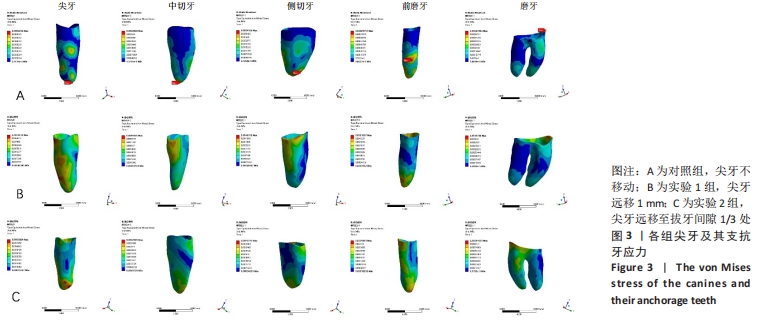
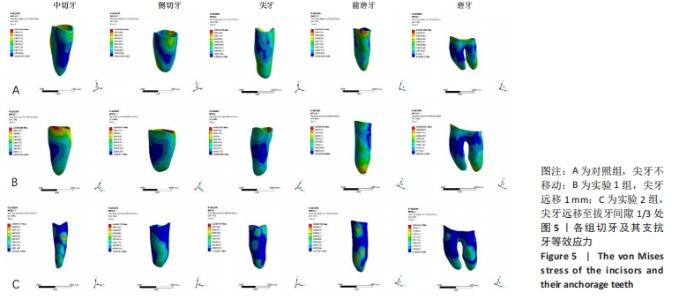
对照组中切牙最大等效应力为0.005 302 3 MPa,侧切牙最大等效应力为0.002 609 6 MPa,为3组中最小值;支抗磨牙最大等效应力为0.000 564 MPa,为同组支抗牙中受力最小值;支抗尖牙最大等效应力为0.001 617 8 MPa,支抗前磨牙最大等效应力为0.002 878 7 MPa。实验1组中切牙、侧切牙最大等效应力分别为0.008 208 8,0.003 642 7 MPa;支抗磨牙最大等效应力为0.000 346 4 MPa,为同组支抗牙中最小值;支抗尖牙等效应力最大,为0.005 250 1 MPa;支抗前磨牙最大等效应力为0.002 570 6 MPa。实验2组中切牙最大等效应力为0.009 932 7 MPa,侧切牙最大等效应力为0.008 171 1 MPa,为3组中等效应力最大值;支抗磨牙最大等效应力为0.000 022 3 MPa,为同组支抗牙中最小值;支抗前磨牙最大等效应力为0.008 779 6 MPa,略大于支抗尖牙最大等效应力0.008 413 4 MPa。各组切牙及其支抗牙等效应力见图5。 "
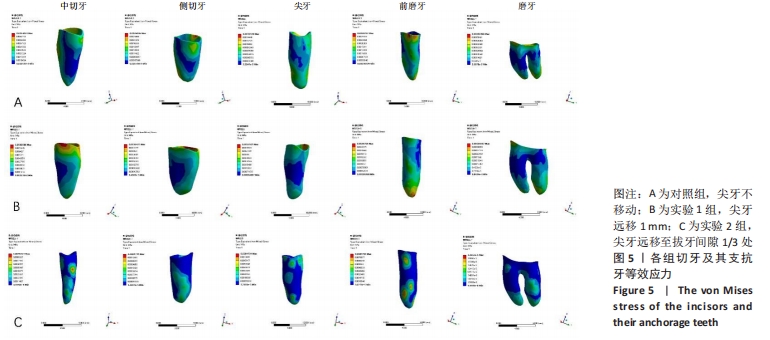
| [1] CASTROFLORIO T, GARINO F, LAZZARO A, et al. Upper-incisor root control with Invisalign appliances. J Clin Orthod. 2013;47(6):346-351, 387. [2] SYCINSKA-DZIARNOWSKA M, BIELAWSKA-VICTORINI H, BUDZYŃSKA A, et al. The Implications of the COVID-19 Pandemic on the Interest in Orthodontic Treatment and Perspectives for the Future. Real-Time Surveillance Using Google Trends. Int J Environ Res Public Health. 2021;18(11):5647. [3] GIANCOTTI A, GARINO F, MAMPIERI G. Use of clear aligners in open bite cases: an unexpected treatment option. J Orthod. 2017;44(2):114-125. [4] PHAN X, LING PH. Clinical limitations of Invisalign. J Can Dent Assoc. 2007;73(3):263-266. [5] CHARALAMPAKIS O, ILIADI A, UENO H, et al. Accuracy of clear aligners: A retrospective study of patients who needed refinement. Am J Orthod Dentofacial Orthop. 2018;154(1):47-54. [6] 周勇全,侯万邦,余侠,等.无托槽隐形矫治器对成人拔牙患者上中切牙压低效率的影响[J].重庆医学,2021,50(16):2721-2725. [7] DAI F, XU T, SHU G. Comparison of achieved and predicted crown movement in adults after 4 first premolar extraction treatment with Invisalign. Am J Orthod Dentofacial Orthop. 2021;160(6):805-813. [8] TUNCER NI, OZCIRPICI AA. Treatment of Class II, Division 2 Malocclusion with Miniscrew Supported En-Masse Retraction: Is Deepbite Really an Obstacle for Extraction Treatment? Turk J Orthod. 2017;30(3):84-88. [9] KHOSRAVI R, COHANIM B, HUJOEL P, et al. Management of overbite with the Invisalign appliance. Am J Orthod Dentofacial Orthop. 2017; 151(4):691-699. [10] BOYD RL. Surgical-orthodontic treatment of two skeletal Class III patients with Invisalign and fixed appliances. J Clin Orthod. 2005;39(4): 245-258. [11] KRIEGER E, SEIFERTH J, MARINELLO I, et al. Invisalign® treatment in the anterior region: Were the predicted tooth movements achieved? J Orofac Orthop. 2012;73(5):365-376. [12] KRAVITZ ND, KUSNOTO B, BEGOLE E, et al. How well does Invisalign work? A prospective clinical study evaluating the efficacy of tooth movement with Invisalign. Am J Orthod Dentofacial Orthop. 2009; 135(1):27-35. [13] AL-BALAA M, LI H, MA MOHAMED A, et al. Predicted and actual outcome of anterior intrusion with Invisalign assessed with cone-beam computed tomography. Am J Orthod Dentofacial Orthop. 2021; 159(3):e275-e280. [14] HENICK D, DAYAN W, DUNFORD R, et al. Effects of Invisalign (G5) with virtual bite ramps for skeletal deep overbite malocclusion correction in adults. Angle Orthod. 2021;91(2):164-170. [15] BLUNDELL HL, WEIR T, KERR B, et al. Predictability of overbite control with the Invisalign appliance. Am J Orthod Dentofacial Orthop. 2021; 160(5):725-731. [16] FUJIYAMA K, KERA Y, YUJIN S, et al. Comparison of clinical outcomes between Invisalign and conventional fixed appliance therapies in adult patients with severe deep overbite treated with nonextraction. Am J Orthod Dentofacial Orthop. 2021;S0889-5406(21)00623-5.doi: 10.1016/j.ajodo.2020.08.023. [17] GALAN-LOPEZ L, BARCIA-GONZALEZ J, PLASENCIA E. A systematic review of the accuracy and efficiency of dental movements with Invisalign®. Korean J Orthod. 2019;49(3):140-149. [18] BOWMAN SJ, CELENZA F, SPARAGA J, et al. Creative adjuncts for clear aligners, part 2: Intrusion, rotation, and extrusion. J Clin Orthod. 2015; 49(3):162-172. [19] 刘爱荣,朱彤,陈关宝.基于有限元方法和临床数据分析的两种前牙压低方法的对比分析[J].全科口腔医学电子杂志,2018,5(27):53-54. [20] LIU Y, HU W. Force changes associated with different intrusion strategies for deep-bite correction by clear aligners. Angle Orthod. 2018;88(6):771-778. [21] 顾泽旭.无托槽隐形矫治的支抗控制及临床策略[J].中华口腔医学杂志,2020,55(8):531-535. [22] 赖文莉.浅谈无托槽隐形矫治技术减数矫治的临床体会[J].中华口腔医学杂志,2017,52(9):534-537. [23] GIANCOTTI A, MAMPIERI G, GRECO M. Correction of deep bite in adults using the Invisalign system.J Clin Orthod. 2008;42(12):719-726. [24] BRIGHT JA. A review of paleontological finite element models and their validity. J Paleontol. 2014;88(4):760-769. [25] 谢乙加,陈亚群,赵青.无托槽隐形矫治系统的相关生物力学研究及病例[J].国际口腔医学杂志,2015,42(4):439-441. [26] 路苗苗,赵凝.不同移动方式下隐形矫治器的三维有限元分析[J].医用生物力学,2019,34(5):522-528. [27] 刘广美,刘海霞,吴晓亚,等.生理性支抗控制矫治器技术结合压低辅弓打开咬合的三维有限元建模及数值分析[J].中国组织工程研究,2017,21(30):4817-4822. [28] 唐娜,赵志河,王军,等.无托槽隐形矫治技术生物力学效应的有限元法研究[J].医用生物力学,2010,25(6):399-405. [29] 雷雪.无托槽隐形矫治器压低下前牙的三维有限元分析[D].兰州:兰州大学,2018. [30] 周平秀.无托槽隐形矫治器对上颌侧切牙转矩力的三维有限元分析[D].杭州:浙江大学,2013. [31] JIANG T, WU RY, WANG JK, et al. Clear aligners for maxillary anterior en masse retraction: a 3D finite element study. Sci Rep. 2020;10(1):10156. [32] 向晓松,苍松.无托槽隐形矫治技术拔除前磨牙的支抗设计与临床控制[J].口腔医学研究,2020,36(2):117-120. [33] ZHU Y, HU W, LI S. Force changes associated with differential activation of en-masse retraction and/or intrusion with clear aligners. Korean J Orthod. 2021;51(1):32-42. [34] WOMACK WR. Four-premolar extraction treatment with Invisalign. J Clin Orthod. 2006;40(8):493-500. [35] LAGANÀ G, MALARA A, LIONE R, et al. Enamel interproximal reduction during treatment with clear aligners: digital planning versus OrthoCAD analysis. BMC oral health. 2021;21(1):199. [36] BOWMAN SJ. Improving the predictability of clear aligners. Semin Orthod. 2017;23(1):65-75. [37] MORTON J, DERAKHSHAN M, KAZA S, et al. Design of the Invisalign system performance. Semin Orthod. 2017;23(1):3-11. [38] 姜若萍,阮梦娇,杜飞宇,等.无托槽隐形矫治器治疗成人牙列间隙伴深覆(牙合)病例[J].中华口腔正畸学杂志,2014,21(4):221-225. [39] 张延晓,陈贵.Spee曲线的整平与间隙[J].中华口腔正畸学杂志, 2016,23(3):158-162. [40] KARRAS T, SINGH M, KARKAZIS E, et al. Efficacy of Invisalign attachments: A retrospective study. Am J Orthod Dentofacial Orthop. 2021;160(2):250-258. [41] 庞国宝.无托槽隐形矫治技术对下颌前牙列矫正的有限元分析[D].太原:太原理工大学,2020. [42] CORTONA A, ROSSINI G, PARRINI S, et al. Clear aligner orthodontic therapy of rotated mandibular round-shaped teeth: A finite element study. Angle Orthod. 2020;90(2):247-254. [43] 胡炜.试论无托槽隐形矫治的垂直向控制[J].中华口腔医学杂志, 2020,55(8):526-530. [44] 刘秒,张军梅.三维有限元模型中无托槽隐形矫治器压低时下切牙的应力分布[J].贵州医科大学学报,2017,42(5):579-582. [45] RUDOLPH DJ, WILLES PMG, SAMESHIMA GT. A finite element model of apical force distribution from orthodontic tooth movement. Angle Orthod. 2001;71(2):127-131. [46] HEMANTH M, RAGHUVEER HP, RANI MS, et al. An Analysis of the Stress Induced in the Periodontal Ligament during Extrusion and Rotation Movements: A Finite Element Method Linear Study Part I. J Contemp Dent Pract. 2015;16(9):740-743. [47] WELTMAN B, VIG KWL, FIELDS HW, et al. Root resorption associated with orthodontic tooth movement: A systematic review. Am J Orthod Dentofacial Orthop. 2010;137(4):462-476. |
| [1] | Wei Guoqiang, Li Yunfeng, Wang Yi, Niu Xiaofen, Che Lifang, Wang Haiyan, Li Zhijun, Shi Guopeng, Bai Ling, Mo Kai, Zhang Chenchen, Xu Yangyang, Li Xiaohe. Biomechanical analysis of non-uniform material femur under different loads [J]. Chinese Journal of Tissue Engineering Research, 2022, 26(9): 1318-1322. |
| [2] | Zhang Yufang, Lü Meng, Mei Zhao. Construction and verification of a full spine biomechanical model of adolescent scoliosis [J]. Chinese Journal of Tissue Engineering Research, 2022, 26(9): 1351-1356. |
| [3] | Zhang Jichao, Dong Yuefu, Mou Zhifang, Zhang Zhen, Li Bingyan, Xu Xiangjun, Li Jiayi, Ren Meng, Dong Wanpeng. Finite element analysis of biomechanical changes in the osteoarthritis knee joint in different gait flexion angles [J]. Chinese Journal of Tissue Engineering Research, 2022, 26(9): 1357-1361. |
| [4] | Li Guijun, Fang Xiaohui, Kong Weifeng, Yuan Xiaoqing, Jin Rongzhong, Yang Jun. Finite element analysis of the treatment of hallux valgus deformity by microplate combined with super strong suture elastic fixation [J]. Chinese Journal of Tissue Engineering Research, 2022, 26(6): 938-942. |
| [5] | Wen Mingtao, Liang Xuezhen, Li Jiacheng, Xu Bo, Li Gang. Mechanical stability of Sanders II type calcaneal fractures fixed by two internal fixation methods [J]. Chinese Journal of Tissue Engineering Research, 2022, 26(6): 838-842. |
| [6] | Wang Hailong, Li Long, Maihemuti·Yakufu, Chen Hongtao, Liu Xu, Yilihamu·Tuoheti. Finite element analysis of stress distribution of acetabular prosthesis in the Lewinnek safety zone [J]. Chinese Journal of Tissue Engineering Research, 2022, 26(6): 843-847. |
| [7] | Wei Bing, Chang Shan. Finite element analysis of different angles of nail placement in sagittal plane of spinal fracture [J]. Chinese Journal of Tissue Engineering Research, 2022, 26(6): 864-869. |
| [8] | Zhang Jianguo, Chen Chen, Hu Fengling, Huang Daoyu, Song Liang. Design and biomechanical properties of dental implant pore structure based on three-dimensional finite element analysis [J]. Chinese Journal of Tissue Engineering Research, 2022, 26(4): 585-590. |
| [9] | Baibujiafu·Yelisi, Renaguli·Maihemuti, Aizimaitijiang·Saiyiti, Wang Junxiang, Nijiati·Tuerxun. Stress analysis of maxillary central incisor crown implant restoration in different occlusal modes [J]. Chinese Journal of Tissue Engineering Research, 2022, 26(4): 567-572. |
| [10] | Wang Can, Gu Weiping, Jiang Yubin, Zhu Lin, Chen Gang. Finite element analysis of the influence of different implant designs on the stress of mandibular edentulous jaw [J]. Chinese Journal of Tissue Engineering Research, 2022, 26(4): 573-578. |
| [11] | Tong Ling, Xu Yangyang, Li Zhijun, Ma Yuan, Wang Haiyan, Li Xiaohe. Design and finite element analysis of a new type of high adhesion elastic internal fixation alloy plate for anterior cervical spine [J]. Chinese Journal of Tissue Engineering Research, 2022, 26(36): 5741-5749. |
| [12] | Xin Daqi, Wang Guoqiang, Han Di, Xing Wenhua, Fu Yu, Zhu Yong, Zhou Yang, Bai Xianming, He Chenyang, Zhao Yan. Finite element simulation surgical modeling of Lenke 3 adult idiopathic scoliosis: modeling evaluation twice in 5 years [J]. Chinese Journal of Tissue Engineering Research, 2022, 26(36): 5755-5763. |
| [13] | Zhang Qiang, Wu Zongde, Liu Liang, Wei Guohua, Peng Liang. Finite element analysis of medial and lateral locking plates for fixation of externally rotated spiral fractures of the lower tibia [J]. Chinese Journal of Tissue Engineering Research, 2022, 26(36): 5750-5754. |
| [14] | Mi Tao, Ding Junwen, Li Zeqing, Tang Baoming, Ren Rong, Li Zhaowei. Biomechanical properties of a single inferior tibiofibular screw with different angles for fixing inferior tibiofibular injury [J]. Chinese Journal of Tissue Engineering Research, 2022, 26(36): 5770-5774. |
| [15] | Yang Tongchi, Hu Juzheng, Wang Renchong, Xie You, Chen Fanglin, Wen Dingfu, Shi Zhanying. Finite element analysis of femoral neck system for adult Pauwels III femoral neck fracture [J]. Chinese Journal of Tissue Engineering Research, 2022, 26(36): 5775-5780. |
| Viewed | ||||||
|
Full text |
|
|||||
|
Abstract |
|
|||||
